There are four quick methods to enter lambda, sigma, theta, and other Greek letters into the Word document: switch to Symbol font and press the corresponding letter on the keyboard; insert an equation and use Latex-like macros; add AutoCorrect rules; assign a shortcut to lambda, sigma, theta, or another symbol for quick typing.
There are different methods to insert the lambda, sigma, and theta letters in a Word document:
This method is handy when you need to insert symbols rarely, and it works only for Latin or Greek letters.
Anytime when you type the text in the Word document, you can switch to the Symbol font and use the corresponding Latin letters to enter Greek letters:
1. Click Ctrl+Shift+Q to switch your current font to the Symbol font.
2. Use symbols like regular font (e.g., in Symbol font keyboard button "a" equals Greek letter "α", keyboard button "b" equals Greece letter "β", . "l" -> "λ", . "w" -> "ω", etc.):
, ,
Note: This method works for inserting only one letter. Thus, if you want to insert several symbols, you need to repeat these steps for each insertion.
After entering one letter using the Symbol font, the next character uses the previous font.
If you click Ctrl+Shift+Q twice, Word does not switch to the previous font, and the Symbol font doesn't stop working after the first entered symbol. Thus, you will need to change the current font and style later.
This way is perfect if you don't need to care about the format and compatibility with previous versions of Microsoft Office (a recommended approach for physical science and mathematics, which require a lot of math in the text with consistent fonts for all equations and symbols):
1. In the paragraph where you want to insert the symbol, click Alt+= to insert the equitation block:
![]()
2. In the equitation block without any additional efforts, you can enter any letter that you need just by typing \+ Name of the letter:
![]()
, ,
Note: You can create a shorter name; see paragraph III.2.
When you work with many documents and often need to paste only one special symbol, you may not want to insert an equation each time. Microsoft Word offers a helpful feature named AutoCorrect. The AutoCorrect options in Microsoft Word propose two different ways to quickly add any special character, such as a lambda, sigma, or theta letter from the Greek alphabet, or even large pieces of text:
Using this method, you can benefit the Math AutoCorrect options without inserting an equation. To turn on or turn off the AutoCorrect of the Math symbols, do the following:
1. On the File tab, click Options:
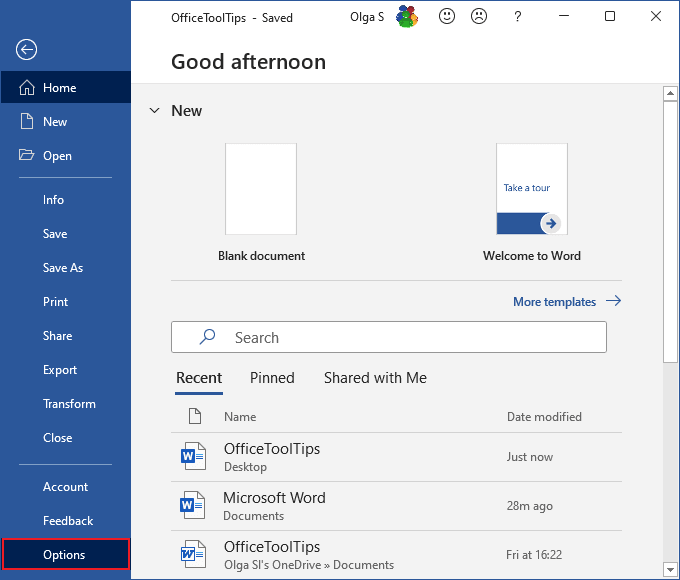
2. In the Word Options dialog box, on the Proofing tab, click the AutoCorrect Options. button:
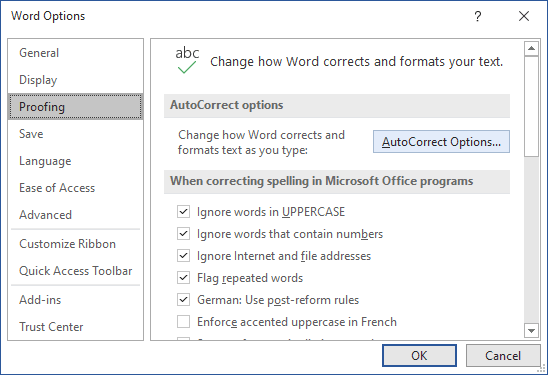 AutoCorrect Options in Word 365" width="548" height="375" />
AutoCorrect Options in Word 365" width="548" height="375" />
3. In the AutoCorrect dialog box, on the Math AutoCorrect tab, select the Use Math AutoCorrect rules outside of the math regions option:
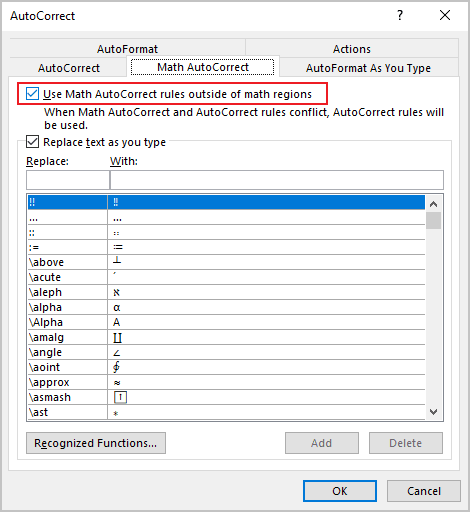
After clicking OK, you can use any of the listed Names of symbols, and Microsoft Word will replace them with the appropriate letters:
Note: If you don't need the last replacement, click Ctrl+Z to cancel it.
Using this method, you can define a sequence to replace it with the Latin or Greek letter. For example, to replace some Greek letter with not short names, it is possible to use:
, ,
To define the new, short names to some Greek letters, do the following:
1. Insert the symbol for which you want to specify the short name, using the Symbol font and select it.
2. On the File tab, click Options.
3. In the Word Options dialog box, on the Proofing tab, click the AutoCorrect Options. button.
4. In the AutoCorrect dialog box, on the AutoCorrect tab:

Microsoft Word offers pre-defined shortcut keys for popular symbols such as lambda, sigma, or theta symbols:
Note: You can see the combination in the Character code field in the Symbol dialog box (see below).
Microsoft Word provides a way to define the shortcut key for the most often used functions. Thus, you can assign a shortcut for inserting the lambda, sigma, or theta letter:
1. On the Insert tab, in the Symbols group, click the Symbol button:
Note: If you use the character very often, you will find it in the Symbol dropdown list:
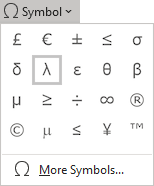
2. Click More Symbols. .
3. On the Symbol dialog box:


4. Choose the symbol and click the Shortcut Key. button to open the Customize Keyboard dialog box:

5. In the Press new shortcut key field, type the key combination that you want to use for the symbol or character (e.g., for symbol λ used Alt+L) and click Assign.
Note: Be careful, you can reassign the assigned already shortcuts in Word. Be sure, that after Current assign to: there are no active Word commands. In any case, you can reassign any existing function in Word to a different key.
Today, 30% of our visitors use Ad-Block to block ads.We understand your pain with ads, but without ads, we won't be able to provide you with free content soon. If you need our content for work or study, please support our efforts and disable AdBlock for our site. As you will see, we have a lot of helpful information to share.
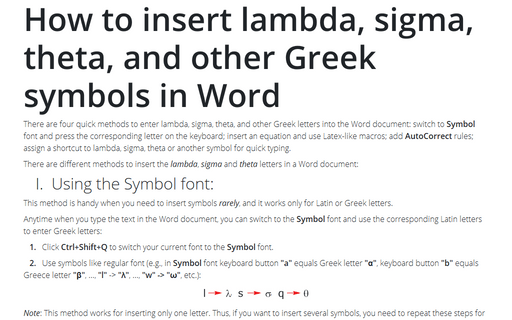
There are four quick methods to enter lambda, sigma, theta, and other Greek letters into the Word document: switch to Symbol font and press the corresponding letter on the keyboard; insert an equation and use Latex-like macros; add AutoCorrect rules; assign a shortcut to lambda, sigma, theta, or another symbol for quick typing.

There are four quick methods to enter lambda, sigma, theta, and other Greek letters into the Word document: switch to Symbol font and press the corresponding letter on the keyboard; insert an equation and use Latex-like macros; add AutoCorrect rules; assign a shortcut to lambda, sigma, theta or another symbol for quick typing.
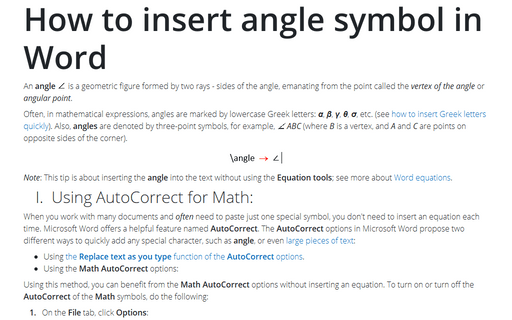
An angle ∠ is a geometric figure formed by two rays - sides of the angle, emanating from the point called the vertex of the angle or angular point.